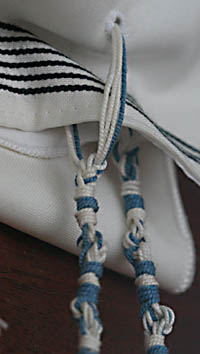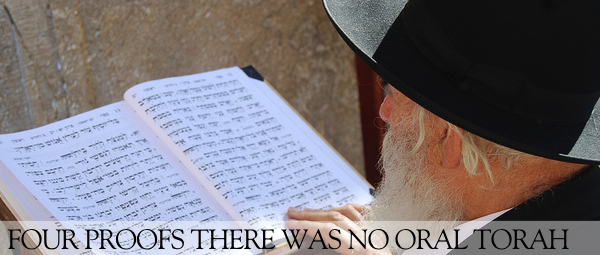
Popular legend has it that the Karaites, and the Sadducees before them, interpreted the words "and they shall be for Totafot between your eyes" literally, and as a result wore Tefillin (Phylacteries) right above their noses. One version of the story claims that the Sadducees were wiped out because of this practice. The legend goes that they kept bumping into walls and since their Tefillin were between their eyes (instead of on their foreheads), their noses were sent shattering into their brains, killing them instantly. The Karaites and other deniers of the "Oral Law" are portrayed as bumbling idiots who through their foolish practices wiped themselves out. The message of this story is that it is impossible to live (literally) as a Karaite, and therefore we need the "Oral Law" to save us from this savage extinction.
The problem with this myth is that it is simply untrue. It assumes that the Karaites and Sadducees interpret the verse "and they shall be for Totafot between your eyes" as referring to Rabbinic Phylacteries. However, in reality the Karaites and Sadducees never wore Tefillin at all, let alone between their eyes because this is simply not what the verse is talking about. One Rabbinite polemicist asked, 'How can you Karaites know how to make Tefillin without all the specifications laid down in the "Oral Law"?'. The answer is we can not because the "Oral Torah" made the whole thing up.
The phrase which allegedly commands the donning of Tefillin appears four times in the Torah (Ex 13,9; Ex 13,16; Dt 6,8-9; Dt 11,18). It should be noted that the difficult word "Totafot" which the Rabbis arbitrarily interpret to mean "Tefillin", actually means "Remembrance". This is clear from Ex 13,9 (one of the four "Tefillin" passages) which substitutes the word "Totafot" with the equivalent but more familiar "Zicharon" (Remembrance).
Upon closer examination it becomes clear that this phrase is a figure of speech and not a command at all. The brilliant Rabbanite commentator Rashbam (Rashi's grandson) was wise enough to realize the true meaning of this expression. Commenting on the verse "And it shall be for a sign upon your hand and a remembrance (Zicharon) between your eyes" he writes:
"'For a sign upon your hand' According to its plain meaning (Omek Peshuto), 'It shall be remembered always as if it had been written upon your hand' SIMILAR TO 'he put me as a seal upon your heart' (Cant 8,6). 'Between your eyes', like a piece of jewelry or gold chain which people put on the forehead for decoration" (Rashbam on Ex 13,9)
Rashi's grandson rightfully interprets the "Tefillin passage" as a metaphor which demands that we remember the Torah always and treasure it like a piece of fine jewelry. Rashbam and the Karaites realize that not everything in the Torah is to be taken literally as a command. The classic example of this is "And you shall circumcise the foreskin of your heart" (Dt 10,16). Obviously God is not commanding mass suicide but is rather commanding us to figuratively circumcise the foreskin of our hearts, i.e. remove our impurity and stubbornness and commit to his covenant with our hearts. While this metaphor was easy to understand it is less obvious what kind of metaphor lays behind "and it shall be for a sign upon your hand and a Remembrance between your eyes ". This question is clarified by several passages elsewhere in the Hebrew Bible....

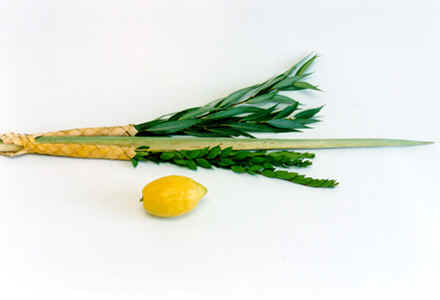 O
n Sukkot, our rejoicing before the Lord is to be done with certain types of produce and plants in hand. (Leviticus 23:40) Traditionally, these have been understood to be the citron (similar to a large lemon in appearance and known by its Hebrew name "etrog"), branches of the date palm tree, and twigs of the myrtle and the willow. Though the name of the palm branch is the "lulav," two sprigs of willow and three of myrtle are bound to the palm branch with strips of palm and the composite of the three together is called the "lulav." Though it could be argued that Leviticus 23:40 can be interpreted in a less specific fashion, the lulav and etrog have been the popular understanding of Israel at least since the days of the Maccabees. They appear on ancient Israelite coins and in early Jewish art along with other well-known symbols like the menorah, the shofar and the Ark of the Covenant.
O
n Sukkot, our rejoicing before the Lord is to be done with certain types of produce and plants in hand. (Leviticus 23:40) Traditionally, these have been understood to be the citron (similar to a large lemon in appearance and known by its Hebrew name "etrog"), branches of the date palm tree, and twigs of the myrtle and the willow. Though the name of the palm branch is the "lulav," two sprigs of willow and three of myrtle are bound to the palm branch with strips of palm and the composite of the three together is called the "lulav." Though it could be argued that Leviticus 23:40 can be interpreted in a less specific fashion, the lulav and etrog have been the popular understanding of Israel at least since the days of the Maccabees. They appear on ancient Israelite coins and in early Jewish art along with other well-known symbols like the menorah, the shofar and the Ark of the Covenant.
According to Maimonides, it is likely that these "four species" as they are known, were chosen to symbolize Israel's emergence from the wilderness into the land of plenty. They were easy to obtain in ancient Israel, two of them have a pleasant smell, and they tend to retain their freshness over the week more than most other plants...

Written by Rich Robinson
 V
isit the home of an observant Jew, and as you enter, you will notice a small rectangular box attached to the outer doorpost. This object is a mezuzah (plural, mezuZOTE). Though it is small, it carries a big message.
V
isit the home of an observant Jew, and as you enter, you will notice a small rectangular box attached to the outer doorpost. This object is a mezuzah (plural, mezuZOTE). Though it is small, it carries a big message.
The Word Mezuzah
In Bible times, mezuzah was simply the word for the doorpost of a house. The mezuzah was where the blood was applied at the first Passover (Exodus 12:7; 22, 23). The mezuzah was where a servant who wanted to serve his master for life would have his ear pierced (Exodus 21:6). We read that Eli, the priest, sat by the mezuzah of the sanctuary (1 Samuel 1:9). In a figure of speech found in Proverbs 8:34, blessedness belongs to the one who waits at Wisdom's doorpost (mezuzah), eager for instruction.
Today the meaning of the mezuzah has been transferred from the doorpost to the box attached to the doorpost. Sometimes the word mezuzah refers even more specifically to the scroll of parchment inside the box, on which two Scripture passages are written. (Traditionally these verses are Deuteronomy 6:4-9 and Deuteronomy 11:13-21, but possible variations will be discussed later.)...

Written by Barney Kasdan
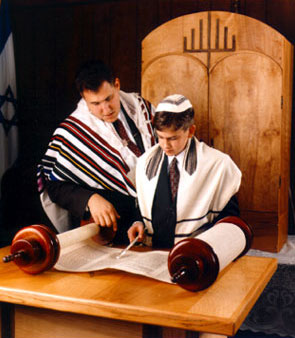 M
y son,, if you accept my words and store up my commands within you, turning your ear to wisdom and applying your heart to understanding, and if you call out for insight and cry aloud for understanding, and if you look for it as for silver and search for it as for hidden treasure, then you will understand the fear of the LORD and find the knowledge of Elohim (Proverbs 2:1-5).
M
y son,, if you accept my words and store up my commands within you, turning your ear to wisdom and applying your heart to understanding, and if you call out for insight and cry aloud for understanding, and if you look for it as for silver and search for it as for hidden treasure, then you will understand the fear of the LORD and find the knowledge of Elohim (Proverbs 2:1-5).
One of the best known customs of the Jewish people is that of Bar/Bat Mitzvah. Whether or not one is from a Jewish background, most people realize that the Bar/Bat Mitzvah is an important step in the life of a Jewish child. As the Hebrew/ Aramaic name implies (bar is Aramaic for "son"; bat is Hebrew for "daughter"; mitzvah is Hebrew for "commandment"), this is a milestone in the life of a Jewish child. It is a time when the child takes responsibility for his or her own religious life. It is considered the biblical age of accountability. The child crosses that precarious gap between childhood and adolescence, with its requisite duties.
The historical background of the Bar/Bat Mitzvah custom is somewhat more difficult to track than many other traditions. This is primarily because there is no specific reference to the ceremony in the Hebrew Scriptures. However, there are dozens of verses that support the idea that there is an age of accountability to the commandments of the Lord. Some would find it ironic that the most detailed account of a Bar Mitzvah in the Bible is actually in the New Testament, at the "Bar Mitzvah" ceremony for Messiah Yeshua....

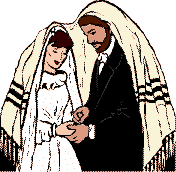 T
here are many customs appointed by Elohim as teaching tools. In a unique way, the Jewish Wedding Ceremony (as opposed to any other cultural expression) is a detailed illustration of the Messiah's relationship to His bride. The Shiddukhin - Arrangements preliminary to Betrothal What is Shiddukhin? Shiddukhin refers to the first step in the marriage process - the arraignments preliminary to the legal betrothal. It was common in ancient Israel of the father of the groom to select a bride for his son. Biblical Example of Shiddukhin - Genesis 24:1-4 Notice in this passage Abraham - makes arrangements for his son Isaac's wedding. While the father usually had the responsibility in Abraham's life it was not possible. It was acceptable for the father to delegate this responsibility by designating a representative - called a shadkhan - marriage broker or matchmaker. The next phase of this step was the - Ketubah Ketubah means - "written" Written in Hebrew as ....
T
here are many customs appointed by Elohim as teaching tools. In a unique way, the Jewish Wedding Ceremony (as opposed to any other cultural expression) is a detailed illustration of the Messiah's relationship to His bride. The Shiddukhin - Arrangements preliminary to Betrothal What is Shiddukhin? Shiddukhin refers to the first step in the marriage process - the arraignments preliminary to the legal betrothal. It was common in ancient Israel of the father of the groom to select a bride for his son. Biblical Example of Shiddukhin - Genesis 24:1-4 Notice in this passage Abraham - makes arrangements for his son Isaac's wedding. While the father usually had the responsibility in Abraham's life it was not possible. It was acceptable for the father to delegate this responsibility by designating a representative - called a shadkhan - marriage broker or matchmaker. The next phase of this step was the - Ketubah Ketubah means - "written" Written in Hebrew as ....

Written by Peggy Pryorr
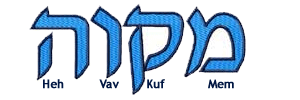 I t is not the intention of the writer to criticize Christendom for the lack of understanding that abounds about immersion, or add to the controversy, or think that by this humble book there will be a great change across the world, that would be very much akin to trying to empty the Atlantic ocean with a tea cup. But for the few hungry souls that cry for understanding I pray that this will be a help. Understanding the Hebrew rites and rituals is a long journey for us that were not exposed to the teaching at an early age, and I dare say that not all that have had the privilege of experiencing them for most or all of their life, see the significance of their teaching as related to Yeshua/Jesus. I shall endeavor to help in a small way to expand on the understanding.
I t is not the intention of the writer to criticize Christendom for the lack of understanding that abounds about immersion, or add to the controversy, or think that by this humble book there will be a great change across the world, that would be very much akin to trying to empty the Atlantic ocean with a tea cup. But for the few hungry souls that cry for understanding I pray that this will be a help. Understanding the Hebrew rites and rituals is a long journey for us that were not exposed to the teaching at an early age, and I dare say that not all that have had the privilege of experiencing them for most or all of their life, see the significance of their teaching as related to Yeshua/Jesus. I shall endeavor to help in a small way to expand on the understanding.
One of the most misunderstood teachings in the Bible is immersion. The Bible has much to say about immersion/or the doctrine of washing/baptisms. The first century believers understood the teachings of the different immersions and their purpose. In this brief writing it will be impossible to explore all the different immersions, but I would like to discuss briefly some of them, and in the process bring a glimmer of light to this most misunderstood teaching in scripture.

"Herod also got together a great quantity of wild beasts,
and of lions in very great abundance, and of such other beasts as were either
of uncommon strength or of such a sort as were rarely seen. These were trained
either to fight one with another, or men who were condemned to death were
to fight with them. And truly foreigners were greatly surprised and delighted
at the vast expenses of the shows, and at the great danger of the spectacles,
but to the Jews it was a palpable breaking up of those customs for which
they had so great a veneration." -Josephus, Antiquities of the Jews.
A righteous man knows the soul of his animal - Proverbs
12:10.
Tza'ar Ba'alei Chayim: Cruelty to Animals
Judaism places great stress on proper treatment of animals. Unnecessary cruelty
to animals is strictly forbidden, and in many cases, animals are accorded
the same sensitivity as human beings. This concern for the welfare of animals
is unusual in Western civilization. Most civilized nations did not accept
this principle until quite recently; cruelty to animals was not outlawed
until the 1800s, and even now it is not taken very seriously.
In the Bible, those who care for animals are heroes, while those who hunt
animals are villains.Jacob, Moses and King David were all shepherds, people
who cared for animals (Gen. 30, Ex. 31, I Sam. 17). The Talmud specifically states that Moses was chosen for his mission because of his skill in caring for animals. "The Holy One,
Blessed Be He, said 'Since you are merciful to the flock of a human being,
you shall be the shepherd of My flock, Israel.'" Likewise
Rebecca was chosen as a wife for
Isaac because of her kindness to animals. When
Abraham's servant asked for water for himself,
she volunteered to water his camels as well, and thereby proved herself a
worthy wife (Gen. 24).
On the other hand, the two hunters in the Bible, Nimrod and
Esau, are both depicted as villains. The Talmud
tells the story of a great rabbi,
Judah Ha-Nasi, who was punished with years
of pain because he was insensitive to the fear of a calf being led to slaughter....

Written by Dr. Michael Brown
 Whether you are a religious Jewish person or not, it is clear that all modern forms of Judaism, from Orthodox to Reform, are based upon the idea that two Torahs were given on Mount Sinai-one written and the other oral. Eventually, the oral Torah was written down, codified, commented upon and passed along to future generations of Jewish people and became known as the Talmud-the judgments and interpretations of our Sages.
Whether you are a religious Jewish person or not, it is clear that all modern forms of Judaism, from Orthodox to Reform, are based upon the idea that two Torahs were given on Mount Sinai-one written and the other oral. Eventually, the oral Torah was written down, codified, commented upon and passed along to future generations of Jewish people and became known as the Talmud-the judgments and interpretations of our Sages.All Jewish people today-whether religious or not-generally participate in Jewish religious life by engaging both biblical truth and the traditions passed along by our rabbis. It is impossible to practice normative Judaism without relating to Jewish tradition. But we should ask the question, "Does Jewish tradition carry the same weight and religious authority as the Bible?"
This might be something that many of our Jewish people take for granted, but have you ever considered the implications of this way of thinking about Elohim and our relationship to Him as Jews?
What do you think about Jewish tradition and Scripture? This is the significant subject addressed by Dr. Michael Brown in the following article.
...............................................................................
If you are an observant Jew, then the rabbinic traditions are very important to you. After all, without the traditions, there would be no such thing as traditional Judaism!
For you, these traditions are your direct connection to Sinai, and you believe that you stand at the end of an unbroken chain of tradition going back to Moses, who, you claim, received both an Oral and a Written Torah from Yehovah. For you, these traditions are essential, telling you how to keep the commandments, how to understand the Scriptures, and how to live your life before the Lord. Without these traditions you would feel lost.

Written by Ron Cantor
What is the Oral Law? And, is it from Elohim?
Orthodox Jews maintain that when Elohim gave Moses the written commandments, he also gave him a secret Oral Tradition or
Torah she-be’al pe.
This was a purportedly a code of conduct and interpretation passed down from generation to generation. The Oral Law supposedly was Elohim’s instruction on how to live out the 613 commandments in the Torah, in addition to other commands in general.
Interestingly enough, the Oral Law is now written down. Around 200 CE Rabbi Judah Hanasi codified, or put into writing, the foundational documents of the Oral Tradition for fear that it might be lost.
Was there really an Oral Law that Moses received?
In short—
no
. And it can be easily proved.
First,
if the Oral Tradition truly came from Sinai then it would have been completely supernatural that it was passed down for over one thousand years unchanged. If my wife sends me to the store to buy five things, unless I write them down, not only will I forget to buy what she asked me to, but I will return home with things that she didn’t ask me to buy! So if it was supernatural, then there would have been no need to write out the Oral Torah as Rabbi Judah Hanasi did in 200 CE. If Elohim had watched over it since Moses, surely He could continue.
Secondly,
there couldn’t have been an Oral Law because in the time of King Josiah,
they had lost the Book of the Law
and it appears that they didn’t even know what Passover was or certainly how to celebrate it! The Temple was in ruins and the King ordered its restoration. In the midst of this great undertaking the Torah was recovered.
Hilkiah the high priest said to Shaphan the secretary, “I have found the Book of the Law in the temple of Yehovah.” (2 Kings 22:8)
The king called all the people together and they read the Book of the Covenant. Together, they renewed the covenant with Yehovah. King Josiah ordered that the Passover be celebrated.
The king gave this order to all the people: “Celebrate the Passover to Yehovah your Elohim, as it is written in this Book of the Covenant.” Neither in the days of the judges who led Israel nor in the days of the kings of Israel and the kings of Judah had any such Passover been observed. But in the eighteenth year of King Josiah, this Passover was celebrated to Yehovah in Jerusalem. (2 Kings 22:21-23)
To summarize, the Torah had been lost as the Temple was in ruins. The king of Israel and the priests did not even know what Passover was—or at least, the details of proper Passover observance. Since the Mishna (the Oral Law in writing, as part of the Talmud) speaks of the Passover at length—in fact it has an entire tractate (major section) called Pesachim (Passovers) that teaches in incredible detail how to correctly celebrate Passover—it had to have been created
after
the time of Josiah. (In fact, the instructions are so detailed, that it becomes ridiculous to think that Elohim is that mechanical. If you want a brief look, .....

Written by Dr. Eitan Bar

Have you ever wondered whether the rabbinic Jewish religion known to us all today is the same Judaism which was practiced in biblical times, in the time of Moses and the prophets?
“Rabbinic Judaism Debunked: Debunking the myth of Rabbinic Oral Law”
Want to read more on this subject? Get the book: “Rabbinic Judaism Debunked: Debunking the myth of Rabbinic Oral Law”
For the past 2000 years, the common term “Torah observant”, regarding the Torah or the commandments, hasn’t really meant what most people think it means. Nowadays, it is simply impossible to keep the commandments of the Torah, as they revolve around the Temple, the Tabernacle, the priesthood, the altar and the heart of it all: Sacrificing offerings to atone for our sins. This has all ceased to exist since the destruction of the Temple, 2000 years ago. Today, the expression “Torah observant”, represents people who follow rabbinic rules. There is almost no connection to Moses and his original commandments anymore.
Truth be told, the rabbis have played the most sophisticated scheme on the nation of Israel: They made us all think that rabbinic rules and traditions, which were invented by them, are in fact “the Law of Moses”. In the next few minutes, we are going to prove to you that the Law of Moses and the rabbinic law have nothing to do with one another and that the “Oral Law” was never given by Elohim on Mount Sinai, but that it is nothing more than urban legend.
WHAT HAPPENED?
During Biblical times, a week before Yom Kippur, the High Priest would leave his home and go to a quiet place, where he could prepare himself on a spiritual level. Come Yom Kippur, the High Priest would not sleep. He would enter the holy of holies for the one and only time of the year, and sacrifice an offering. Firstly, he would have to make an offering for himself, and then a goat to atone for the sins of the nation. The people of Israel would fast in solidarity. Fasting was a marginal, symbolic gesture, and not meant to atone for the nation’s sins of the entire year. The sacrificial blood on the altar was what atoned for the sins of the nation of Israel. Fasting was Israel’s way of expressing their deep, true and heartfelt remorse, relying on the sacrificial offering. According to tradition, when Yom Kippur came to an end, the nation awaited the “official seal”: An official approval from Elohim that He had accepted the sacrifice and that the nation’s sins have been absolved. What was that approval? A red rope hanging in the Temple. A scarlet thread turned white. That was how the High Priest and the entire nation knew that Elohim had accepted their Yom Kippur sacrifice. The people would dance, celebrate and be joyful. Their sins had been wiped out and absolved for another year. In the Gemara, the Sages (Hazal) describe the following:
Roughly 40 years prior to the destruction of the Temple, which was destroyed in the year 70 AD, that same red rope, the scarlet thread, stopped turning white. This caused the nation’s leaders great concern. As of the year 30 AD, Elohim stopped giving His approval on Yom Kippur. The scarlet thread no longer turned white. Elohim was no longer willing to accept the Yom Kippur sacrifice. As of the year 30 AD, Elohim stopped dwelling in the Temple, which, 40 years later, was also destroyed.
Do you remember what happened around the year 30 AD?
From then on, the rabbis had to reinvent Judaism in a way that would work even without Elohim’s approval....

Written by Avram Yehoshua
There are some who teach that Yeshua was a Pharisee because of similar teachings between the two of them (and/or the Rabbis),1 yet, even though some teachings might appear similar on the surface, their substance or essence is as different as salt is from sugar. Alfred Edersheim, the leading authority on Judaism in relation to the New Testament in his day, himself a believing Jew well studied in the Talmud, writes of the theological discontinuity between Yeshua and the Pharisees. Edersheim points out that the teachings of Messiah Yeshua and the Pharisees (and by extension the Rabbis) might at first appear to look similar, but they are radically opposed to one another:
‘we shall thus vividly realise another and most important aspect of the words of Christ. We shall perceive that their form is wholly of the times, their cast Jewish—while by the side of this similarity of form there is not only essential difference, but absolute contrariety of substance and spirit. Jesus spoke as truly a Jew to the Jews, but He spoke not as they—no, not as their highest and best Teachers would have spoken. And this contrariety of spirit with manifest similarity of form is, to my mind, one of the strongest evidences of the claims of Christ.’2
Similarity of saying is important to note because some try and match some of Messiah’s sayings with those of the Talmud, but the question must be asked, ‘Is it of the same spirit,’ and if so, ‘Who said it first?’ Did Yeshua say it first or did a later rabbi add it after having heard Yeshua’s saying? As we’ll see, Yeshua’s words, teachings and lifestyle leave no doubt that they are totally different than the Pharisees, their teachings and lifestyle, and therefore, Yeshua wasn’t a Pharisee.
Confrontation over Doctrine
One perspective that reveals that Yeshua wasn’t a Pharisee are the passages in the New Testament where Yeshua speaks of Pharisaic teachings as those of men (i.e. not of God). Some say that Yeshua only rebuked the Pharisees for their hypocrisy, but not their actual teachings, but this isn’t true.3 The Gospels record clashes over the issue of proper interpretation of Scripture (Mt. 15:1-20; 23:1-39). In Mt. 15, Yeshua sternly rebukes the Pharisees for both their hypocrisy and their man-made teachings:
“You hypocrites! Rightly did Isaiah prophesy of you, saying, ‘This people honors Me with their lips, but their heart is far away from Me. For in vain do they worship Me, teaching as doctrines the precepts of men’” (Mt. 15:7-9).
Yeshua speaks of Pharisaic doctrines as being ‘the precepts of men’ (not just one doctrine and not just an isolated minor doctrine, but doctrines; many). These words of Messiah form a powerful barrier against anyone who thinks that Yeshua was a Pharisee or that their teachings were conceptually the same as His.
Another admonition of Yeshua’s against Pharisaic teachings is when He and the disciples got into a boat to cross over to the other side of the Sea of Galilee. Yeshua warns them about the leaven of the Pharisees (Mt. 16:5-6). They didn’t understand, and Scripture records:
‘Then they understood that He did not say to beware of the leaven of bread, but of the teaching of the Pharisees and Sadducees’ (Mt. 16:11; see also Mk. 8:15; Lk. 12:1).
The problem with Pharisaic teachings, and the Pharisees, is further seen when Yeshua says,
‘But woe to you, Scribes and Pharisees, hypocrites! Because you shut off the Kingdom of Heaven from people! You do not enter in yourselves, nor do you allow those who are entering to go in’ (Matt. 23:13).

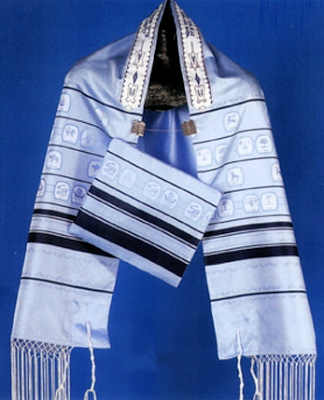 Visit a Saturday morning synagogue service, and you will notice that all the men and many of the boys are draped in white, fringed prayer shawls that are bordered with either blue or black stripes.
Visit a Saturday morning synagogue service, and you will notice that all the men and many of the boys are draped in white, fringed prayer shawls that are bordered with either blue or black stripes.

